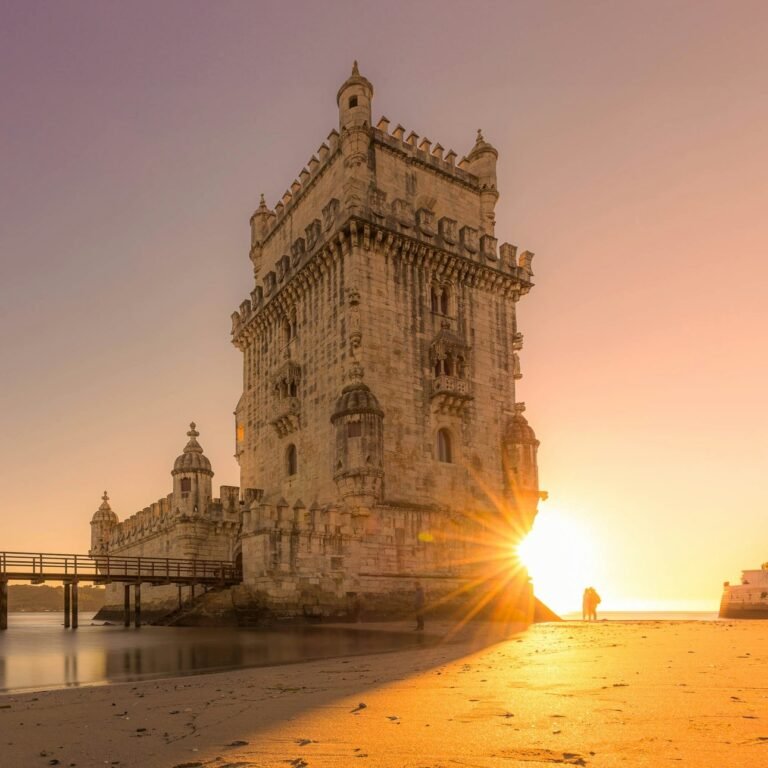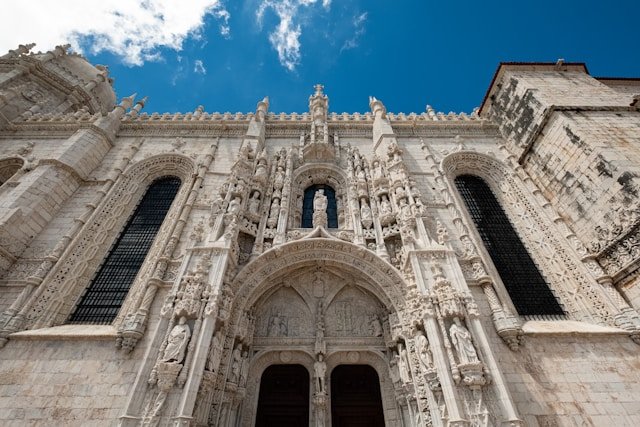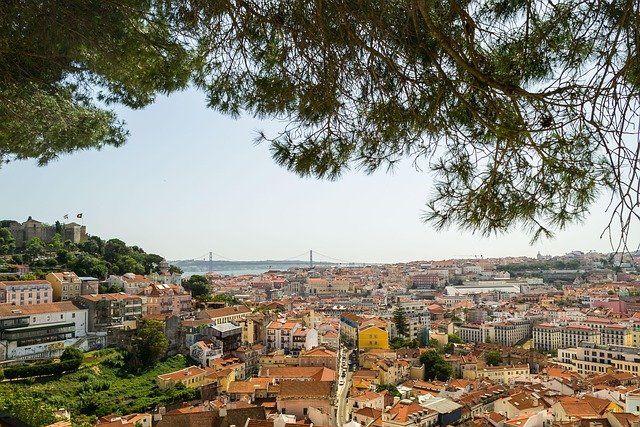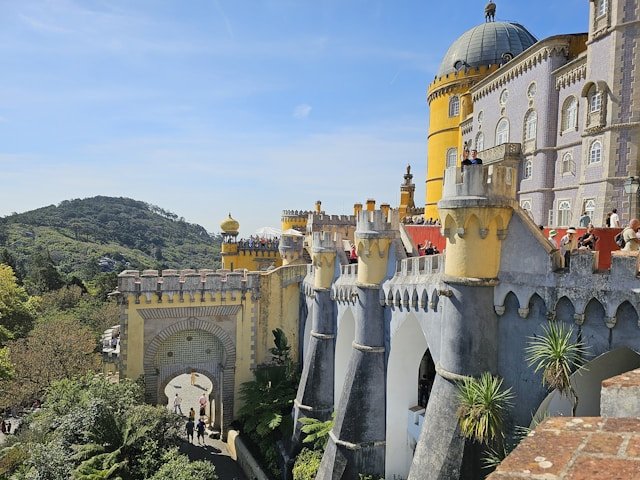Lisbon
THE SAFE HARBOUR

Lisbon, Portugal’s vibrant capital, is a hilly gem where pastel buildings tumble down cobblestone streets toward the Tagus River. Known as the “city of seven hills,” it’s a maze of history and charm—think Alfama’s winding alleys with fado drifting from taverns, or the rattling yellow Tram 28 passing São Jorge Castle and Belém Tower. Don’t skip the famous Pastéis de Belém for a warm custard tart that’s pure bliss.
It helps keep this site running, and we appreciate your support!
Unveiling Lisbon: Must-Visit Sights

Belém Tower
No trip to Lisbon is truly complete without a stop at Belém Tower, a UNESCO World Heritage gem hugging the Tagus River’s edge. This 16th-century fortress, adorned with ornate Manueline details like twisted ropes and maritime carvings, once stood sentinel over the city’s bustling harbor during Portugal’s golden Age of Exploration. Climb its narrow stone stairs to the top terrace, where a cool breeze carries panoramic views of the river, the distant 25 de Abril Bridge, and the sprawling city beyond. Afterward, treat yourself to a well-earned reward at Pastéis de Belém, just steps away, where the warm, flaky custard tarts—sprinkled with cinnamon—are a heavenly bite of local tradition.

Alfama District
Step into Alfama, Lisbon’s oldest and most soulful neighborhood, where a tangle of narrow, cobblestone streets feels like a living postcard from the past. Laundry sways from wrought-iron balconies, and the haunting strains of fado music drift from dimly lit taverns, tugging at your heartstrings. Wander aimlessly past tiled houses, popping into the Gothic Sé Cathedral with its twin bell towers, or pause at the Miradouro de Santa Luzia for a postcard-worthy view framed by bougainvillea. It’s not just one sight but a sensory tapestry—smells of grilled fish, echoes of laughter, and glimpses of the river peeking through the chaos.

Jerónimos Monastery
In the riverside Belém district, the Jerónimos Monastery stands as a breathtaking testament to Portugal’s seafaring past, its honey-colored limestone facade a riot of Manueline flourishes—think nautical knots, coral-like curves, and armillary spheres. Commissioned in the 1500s to honor Vasco da Gama’s voyages, this UNESCO treasure sprawls with airy cloisters and an ornate church where the explorer’s tomb rests. Wander the two-story galleries, tracing the delicate stonework, then step outside to admire how the Tagus reflects its grandeur. It’s a slow, immersive experience, best savored with a quiet moment to feel the weight of history in every carved detail.

Miradouro da Senhora do Monte
For a view that captures Lisbon’s soul, trek up to Miradouro da Senhora do Monte, a serene lookout crowning the city’s highest hill in the Graça district. Far from the tourist throngs, this spot unfurls a jaw-dropping panorama—red-tiled roofs cascading toward the river, the castle aglow, and the 25 de Abril Bridge stretching into the haze. A modest chapel nods to its name, while shady trees and benches invite you to linger with a picnic or a glass of vinho verde. It’s a tranquil escape, offering a rare chance to see Lisbon’s sprawl in all its layered, sunlit glory.

25 de Abril Bridge
Spanning the Tagus with a bold, red silhouette, the 25 de Abril Bridge is Lisbon’s modern icon, often likened to San Francisco’s Golden Gate but with its own rugged charisma. Opened in 1966, it links the city to Almada, its steel lattice gleaming against the sky. You can’t stroll across, but head to the Doca de Santo Amaro marina below for a striking perspective, or dive into the Pilar 7 Bridge Experience—an elevator ride up a pillar to a dizzying glass lookout 80 meters high. It’s a thrilling blend of engineering and scenery, tying Lisbon’s past to its forward-looking present.

Parque das Nações
On Lisbon’s eastern edge, Parque das Nações trades cobblestones for a sleek, futuristic vibe, born from the 1998 Expo’s ambitious makeover of a derelict waterfront. The star is the Oceanário de Lisboa, a world-class aquarium where you can watch penguins waddle and sharks glide in a colossal tank. Stroll the esplanade past avant-garde sculptures, under the cable car’s hum, and alongside the Vasco da Gama Bridge—Portugal’s longest. With waterfront cafes serving octopus salad and breezy paths for biking, it’s a modern playground that contrasts beautifully with Lisbon’s ancient core, ideal for a laid-back day out.
Top Things to Do in Lisbon

National Palace of Pena & Park
A short train ride from Lisbon, the National Palace of Pena crowns the Sintra hills with a riot of color—red, yellow, and blue turrets rising from lush greenery. Built in the 19th century by King Ferdinand II, this Romanticist fantasy blends Gothic, Manueline, and Moorish styles into a whimsical masterpiece. The surrounding Pena Park sprawls over 200 hectares, a maze of exotic trees, hidden ponds, and winding paths begging to be explored. Climb to the High Cross for a view stretching to the Atlantic, and let this fairy-tale escape whisk you away from reality.

Oceanário de Lisboa
Tucked in Lisbon’s modern Parque das Nações, the Oceanário de Lisboa is a marine wonderland, one of Europe’s largest aquariums. Its centerpiece—a massive central tank—teems with sharks, rays, and schools of fish, viewed from multiple levels that mimic a dive into the deep. Designed for the 1998 Expo, its sleek, floating structure juts over the Tagus River, blending nature and architecture. Explore four distinct habitats, from icy Antarctic waters with playful penguins to tropical coral reefs bursting with color. It’s a mesmerizing plunge into the ocean’s depths, perfect for families or anyone awed by underwater worlds.
Lisbon Hop-on Hop-off Tours
See Lisbon your way with a hop-on hop-off bus tour, a flexible ticket to the city’s sprawling charm. Roll past the golden arches of Praça do Comércio, the intricate Belém Tower, and the hilly maze of Alfama, hopping off whenever inspiration strikes. With routes covering historic sites, modern districts, and riverfront views, you’ll catch the city’s pulse—ancient trams clattering by, fado notes in the air, and pastéis de nata tempting at every stop. Audio guides spill tales of explorers and earthquakes, making it an easy, breezy way to soak in Lisbon’s layered story.

Castelo dos Mouros Sintra
High above Sintra’s misty forests, the Castelo dos Mouros looms like a sentinel from the 8th century, its stone walls a relic of Moorish rule. Conquered by Christians in 1147, it fell into ruin until restored as a romantic lookout. Scramble along its rugged ramparts for heart-stopping views—Pena Palace peeking through the trees, the Atlantic glinting in the distance. No grand halls here, just raw history and windswept solitude. A short walk from Pena, it’s a quieter, wilder slice of Sintra’s past, best for those who love a climb and a vista.
Flight Timing, Tips, and Touchdown
Hotels
Five Must-Try Lisbon Dishes to Savor the City’s Soul

These iconic custard tarts are Lisbon’s sweet claim to fame, with their flaky, buttery pastry cradling a creamy, cinnamon-dusted filling. Baked fresh daily, they’re best enjoyed warm, straight from the oven. Head to Pastéis de Belém for the original recipe—crisp, caramelized tops and all—or grab them at any local pastelaria. Pair one with a strong espresso for a classic Lisbon moment that’s simple yet unforgettable.
Salt cod takes center stage in this comforting dish, shredded and mixed with golden fried potatoes, onions, and scrambled eggs, then sprinkled with parsley and black olives. It’s a hearty, homey staple that showcases Portugal’s love affair with bacalhau (cod), prepared in countless ways here. You’ll find it on menus across the city, from cozy tascas to upscale spots—each bite is a taste of tradition with a satisfying, savory kick.
Grilled sardines are a summer star in Lisbon, especially around the Santo António festival in June, but they’re a treat year-round. Fresh from the Atlantic, they’re charred over open flames, served whole with a drizzle of olive oil, a squeeze of lemon, and a side of boiled potatoes or crusty bread. The smoky, salty flavor shines through, making this a messy, hands-on delight best enjoyed at a riverside grill or local eatery.
This soul-warming soup blends creamy potatoes with thin ribbons of kale and a punch of smoky chouriço sausage, creating a rustic dish that’s pure comfort in a bowl. It’s a northern Portuguese classic that’s beloved in Lisbon too, often served as a starter or late-night bite. The texture is velvety yet hearty, and the sausage adds a spicy depth—perfect for cooler evenings or a quick, flavorful lunch.
A street food gem, the bifana is a no-fuss pork sandwich that packs a punch. Thinly sliced pork is simmered in a garlicky, paprika-spiked sauce, then piled into a crusty roll that soaks up all the juices. Some spots add a dab of mustard or a kick of piri-piri for extra zing. It’s cheap, messy, and delicious—grab one at a hole-in-the-wall joint like O Trevo near Praça das Flores and eat it standing, soaking in the local vibe.
Essential Tips for Exploring Lisbon
Public Transport Made Simple
Best Times to Visit Lisbon - Season-by-Season
Spring stands out as an ideal time to visit Lisbon, with mild temperatures averaging 60-70°F (15-21°C) and blooming flowers adding color to the city’s parks and streets. Rainfall is light and sporadic, making it perfect for walking the hilly neighborhoods or enjoying outdoor cafes without the summer crowds. Days grow longer, offering ample time to explore sights like Alfama or Belém, and prices for flights and hotels tend to be reasonable before the peak season rush. It’s a sweet spot for pleasant weather and a relaxed vibe.
Summer brings Lisbon’s hottest weather, with temperatures climbing to 80-90°F (27-32°C) and long, sunny days that draw big crowds to its beaches and festivals. The energy is high—think open-air concerts and the Santo António festivities in June—but the heat can feel intense on the cobblestones, and popular spots get packed. Accommodation costs rise, and lines for attractions lengthen. It’s best for those who love a lively atmosphere and don’t mind the bustle or warmth.
Fall offers a strong case for visiting Lisbon, as the summer heat fades to a comfortable 65-75°F (18-24°C), and the tourist surge eases up. The light stays golden, perfect for photography at miradouros or along the Tagus, while occasional rain keeps things fresh rather than disruptive. Lower hotel rates and shorter queues make it a practical choice, blending good weather with a quieter pace—ideal for a laid-back trip with plenty of charm.
